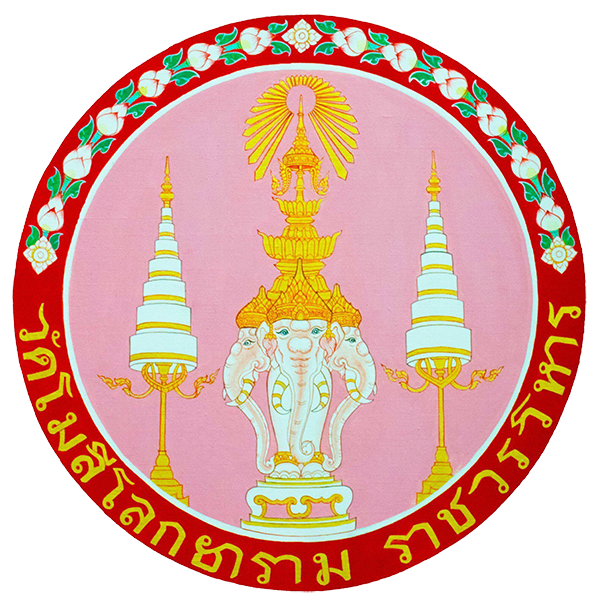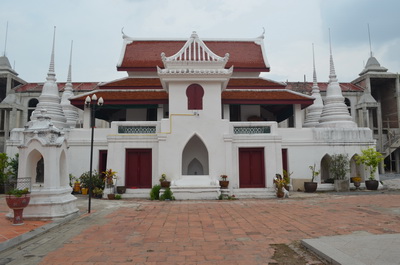 |
 |
 |
 |
 |
|
|
||||||
History of the Temple
 Wat Molilokayaram Rajaworawihan By Phra Theppariyattimolee (Sutas), The Abbot.  Wat Moli Lokayaram is a royal temple of the second tier, which is known as “Rajworawihan”. This 300-year old temple was built in the Ayudhaya period. When King Taksin established the Thonburi Kingdom, he incorporated this temple and Wat Arun into his palace boundary. During his reign, there were therefore no monks residing in the temple and was considered as the temple within the palace as usually practiced in the Ayudhaya Kingdom. This temple was widely known during the Thonburi period as “Wat Tai Talad” which literally means the temple behind the market. This temple stretches for 5.1 acres and situates behind King Taksin’s old palace on the western side of the Chao Praya River, which is called Thonburi. Wat Moli Lokayaram is a royal temple of the second tier, which is known as “Rajworawihan”. This 300-year old temple was built in the Ayudhaya period. When King Taksin established the Thonburi Kingdom, he incorporated this temple and Wat Arun into his palace boundary. During his reign, there were therefore no monks residing in the temple and was considered as the temple within the palace as usually practiced in the Ayudhaya Kingdom. This temple was widely known during the Thonburi period as “Wat Tai Talad” which literally means the temple behind the market. This temple stretches for 5.1 acres and situates behind King Taksin’s old palace on the western side of the Chao Praya River, which is called Thonburi.
The oldest structure of this monastery is the Assembly Hall or Wihan which was built in the Ayudhaya period and later King Taksin used it for storing salt in Thonburi period. It is sometimes called “Phra Wihan Chag Klua” in Thai, which means a salt storage. This hall is characterised with the Thai-Chinese architecture covering with ceramic roof tiles and gable spires and ridges decorated with stuccowork. The hall was separated into two chambers. In the smaller rear chamber stands a large image of seated Lord Buddha in the attitude of subduing Mara named “Phra Parames”. The front larger chamber contains several sacred Buddha images on the middle pedestal, each of which has very beautiful Buddha characters. Wooden doors and windows were beautifully carved with gilded lacquer art. This assembly hall has a magnificent unique rare character and is very worth seeing
In the reign of King Rama I, the capital city was moved to the other side of the Chao Praya River, which was called the Pra Nakorn east bank or the Main City. He ordered his son, Prince Isarasundhorn, who was later King Rama II, and HM. Queen Amrindramard (Nak) to restore this temple and build a new Ubosot or chapel, respectively. The chapel is covered with the ceramic roof tiles with timber gable spires and their ridges, lacquered and decorated with stained glass. The wall and the ceiling inside the temple are painted in the traditional Thai print. Wooden doors and windows were beautifully carved with gilded lacquer.  The Principle Buddha Image in the Temple, named “Phra Buddha Molilokanadh”, is a bronze Buddha image in the attitude of subduing Mara having the front lap width of 2 metres with very beautiful Buddha characters. This image is very sacred and has been respected by the kings and Thai people since early Rattanakosin period. The Principle Buddha Image in the Temple, named “Phra Buddha Molilokanadh”, is a bronze Buddha image in the attitude of subduing Mara having the front lap width of 2 metres with very beautiful Buddha characters. This image is very sacred and has been respected by the kings and Thai people since early Rattanakosin period.
King Rama II renamed this monastery “Wat Buddhaisawan” or “Wat Buddhai Sawan-yawas Worawihan”, which implies the close relationship with the royal family. Almost all of his sons, including Kings Rama III and IV and HM Vice King Pinklao, had their elementary study here. King Rama III had restored the whole temple and again renamed it “Wat Moliloksudharam”.
King Rama IV built a new chamber for the abbot, a Chanting Hall and subsequently a larger Central Hall serving both chanting and dining purposes. He restored the chapel by allowing his royal emblem of the mythological elephant with the royal canopy be placed on its gable. It is very likely that the present name of the temple –“MoliLokayaram” was given in this reign. Access to Wat Molilokayaram The temple is also accessible by boat or express boat across the Chao Praya River from Ta Tian Pier to Wat Arun Pier or from Pak Klong Talad Pier to Wat Kalayanamit Pier and then going on foot to Wat Moli lokayaram. Map of the temple is available at the temple website. Molilokayaram Educational InstituteAs previously mentioned, this temple had been served as an elementary school for many princes of King Rama II during early Rattanakosin period. It also provided the Pali language teaching with oral examinations. In 1991 Wat Molilokayaram was appointed to be the monastic educational institute with an aim to provide the education of dhamma scriptures of both Pali language and dhamma essence (Nakdham) and plans to supply very qualified Buddhist descendants. At present, although this institute is of medium size and generates 100-200 monks examinee to enter the annual central Pali-examination, it wins respectively the record of achieving the highest number of students passing the Pali-examination in Bangkok Metropolitan in 2007, 2009, 2010, 2011, 2012 and the outstanding students had received the administration scholarship. At present there are altogether 20 teachers and 100-140 student monks/novices. The institute also provides Pali courses for students from other temples in Bangkok Metropolitan and upcountry. The Pali section has eight levels giving classes on Pali grammar up to the ninth level of Buddhist theology, while Dhamma section has three levels of classes, i.e dhamma scholar of the third, second and advanced levels. The monastery has very limited space and facilities and needs to improve both classrooms and accommodations tremendously in order to cope with more than 200 monks/novices each year.
1. Annual Pali Tuition Prior to the Test at Pra Mane Ground (Snam Luang)The Pali tuition is given to more than 250 monks and novices holding Buddhist Theology of lower levels 1-2 up to level 9 from end of December to beginning of March of the following year. Sponsorship providing foods and drinks or financial support for monks during this period is greatly appreciated.
2. Ceremony of Buddhist Theology and Merit Making for the Late AbbotsThe ceremony is annually arranged on the second Sunday of September. Scholarships and the three robes will be given to the outstanding monks/novices, who can pass annual Pali-examination. Merit making is performed for the late abbots of the temple.
You can donate money to support these Routine Activities of the Institute everyday. Contact Phra Medheewaraporn, the abbot.
Address : Wang Derm Road, Wat Arun Sub-district, Bangkokyai District , Bangkok 10600, Thailand Tel. +66 2-472 8147 Fax. +66 2-472 8147 Mobile +66 89-660 1464 Email: waratassee@hotmail.com |
||||||
|
|
||||||||||||||||||||||||||||||||||||||||||||||||||||||||||||
โทร. 0-2472-8147 มือถือ 089-660-1464 แฟกซ์. 0-2472-8147
แผนที่วัดโมลีโลกยาราม | พัฒนาเว็บไซต์โดย schooljob.in.th หางานโรงเรียน สมัครเป็นครู ทุกสาขาทั่วไทย
 ประวัติ วัดโมลีโลกยาราม
ประวัติ วัดโมลีโลกยาราม








